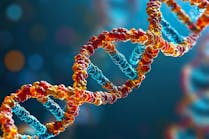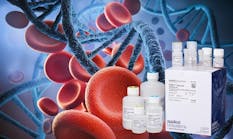There are a lot of things that can be different between any two clinical MDx laboratories, but it’s probably a very safe guess that one thing they all have in common is that sample storage space—particularly refrigerated storage space—is at a premium. (Sure, there’s a few of you out there smirking; you have shiny new labs and plenty of storage. Just wait, you’ll see how quickly it fills up!) Depending on the particular focus and sample streams coming into an MDx lab, a variety of things might be stored for either short or long durations—including raw specimens, isolated microorganisms, and extracted nucleic acids from other specimen types. Our focus this month is on that last example, and particularly when the nucleic acid of primary interest is DNA.
Aqueous storage—the norm
Normally, one thinks of such specimens being stored in aqueous solution at subzero temperatures; -20°C or even -80°C. The commonality of this approach arises out of convenience in more than one aspect. When nucleic acid extracts are prepared for analysis, they’re in aqueous medium to allow for downstream analyses including quantitation and various molecular test approaches, all of which occur—at least on a microscopic level—in aqueous reactions. Normally this medium is buffered (unbuffered pure water isn’t great for storing DNA, as it can be subject to wild pH swings particularly during freezing and thawing; either low or high pH can damage DNA) and often contains things like EDTA, a metal chelator which can trap stray metal ions which also might contribute to DNA damaging reactions. You’ve already got this extract in hand, so the easiest thing to do is put it in a freezer box, scrape away the mounds of hoarfrost as needed, and bury the box deep in the back of a lab freezer. DNA can be stable in that format for a very long time; if it’s a -80°C freezer, so can RNA. When cause arises to examine that sample again for whatever reason, it’s again pretty convenient in that once the sample is retrieved from cold storage, it can just be thawed and an aliquot taken for whatever testing is desired. You can even return any remaining sample excess back into storage, although repeated freeze thaw cycles will eventually take a toll (as touched on in this very space in September, 2015).
The reader can likely recite the downsides of this approach, though. Freezers take up space and have relatively limited capacities; they require a basically uninterrupted electricity supply to operate (and if they are at much density, likely for building HVAC capacity to handle the waste heat generated); compressors do fail, sometimes with little warning (apocryphally, most likely on a Friday evening on a long weekend); and even with perfect record keeping telling you which shelf, case, box, and slot number to find your wanted sample, there’s an at least even chance that it’s in an obscure, inconvenient back corner of somewhere and hard to get at. An extension of the need for electricity is that freezer storage is also not generally suitable for low resource environments, although most labs don’t have to take this into account.
Enter DBS
There is another approach to long term storage of DNA, which can exchange these conveniences and inconveniences for its own set: dehydrated DNA. Almost all forms of DNA damage which lead to degradation and poor suitability for MDx analysis occur through chemical processes which occur in at least microscopic amounts of water. If you can remove this water, then DNA is very stable even at room temperature if it’s kept out of direct light. The most direct lab example of this comes in the form of blood spot “DBS” cards, like the neonatal heel prick spots collected onto filter paper, common since the mid 1960s, as a method for testing for phenylketonuria and only more recently seen as archives of DNA. Simply dried onto small labeled pieces of porous filter paper and stored side by side in boxes on a shelf, enormous numbers of total specimens (albeit at very low volume each) can be kept in a small storage space under ambient conditions for many years—assuming ambient isn’t very humid. Flipping through a racked box of such samples is akin to searching through a card catalogue, which although perhaps ancient history to some readers is readily learnt, and rather more convenient than digging through freezer boxes. It’s not hard to compare in one’s imagination the space taken up by a few thousand slips of filter paper—perhaps a few shoebox size containers—versus a regular freezer or so for the same number of racked microfuge tubes.
How stable are dried blood spot (DBS) samples? The answer to that probably depends on what downstream assay(s) will be attempted, as even desiccated DNA may be prone to fragmentation by ionizing radiation; methods working with short DNA fragments may thus prove most robust than those requiring longer sections. With that caveat in mind however the consensus is that DBS samples more than 20 years old are routinely viable for assays such as SNP genotyping.1 Even if storage conditions are episodically less than ideal, evidence suggests that short-term “storage insults” such as 60 percent humidity and 37°C for seven days have little to no significant impact2 on PCR based test results.
How much DNA is recoverable from a DBS? The answer of course varies with the size of the original blood spot, but compared to a frozen liquid sample, it’s safe to say “not much.” With the sensitivity of PCR based assays however, it’s usually more than sufficient; reference [1] for example states that “thousands of SNPs” can routinely be analyzed from even small blood spots. While some risk of sequence biasing may occur and it’s not cheap, it’s also possible to use DBS DNA as a template for whole genome amplification processes yielding larger amounts of material if needed. Such amplified material may be used for sequencing and similar processes.3
Matrices for dried storage of extracted DNA
What about sample types other than blood, or more generically, what about aqueous phase DNA extracts already on hand—are there possible approaches to storing these by dehydration? Yes, there are a few such approaches (both homebrew and commercial) and they’ve been around long enough to have reasonable real life stability data available. The simplest of these is just spotting DNA onto filter paper much like the DBS. This method is in fact commonly employed for shipping bacterial plasmids (small circular DNA molecules useful primarily as cloning tools or expression vectors) between labs. Under ambient storage, this is generally considered reliable for short to medium durations but losses in DNA integrity over longer terms (i.e. > 3 months) have been reported.4 It seems then that for naked DNA, some better matrix than filter paper may be in order.
The most common, “better matrix,” is the disaccharide sugar trehalose, which is naturally occurring and in fact is produced and used by a number of organisms which can survive dessication (“anhydrobiosis”), such as tardigrades. Trehalose is believed to work by coating DNA molecules and effectively displacing H-bonded water molecules with its own H-bond donors and acceptors. Once in place, it has low hygroscopicity, low chemical reactivity, and works to keep any stray water molecules away from the DNA. (One suspects it might also act in a sacrificial capacity toward reactive radical molecules, in effect defusing their reactivity prior to reaching the coated DNA.) Use of trehalose is very easy, usually being mixed in an aqueous DNA sample to a final concentration of around 1.5 percent in an open format such as a 384 well plate and then allowed to air dry either at room temperature or slightly elevated (50–60°C). The sample can then be stored under ambient conditions and to use the sample, it is just rehydrated and a suitable portion is taken. The trehalose doesn’t interfere with common downstream MDx processes, and unlike extraction from dried paper storage (which usually involves destruction of the paper), remaining excess sample can just be left to dry down again without further work. DNA extracts stored this way have been demonstrated stable for at least two years, with (somewhat paradoxically) better longevity at elevated storage temperatures.5
Another storage adjuvant with similar utility is polyvinyl alcohol (PVA). Most readers will be familiar with this material and may even have some lurking around the house, disguised in its more common commercial guise as wood glue. Although long polymers, PVA behaves similarly to trehalose in this application by closely associating with and coating individual DNA strands, providing H-bond donors and acceptors and displacing most if not all of the hydrating water molecules. Use of PVA is similar to trehalose, at final concentrations around 0.15 percent with buffering (e.g. Tris), and shows even better stability than trehalose treated samples (particularly at lower DNA concentrations;5 more about that below).
Finally, there are proprietary commercial reagents for dry DNA storage. As customary in this space we’ll avoid naming specific names for fear of the appearance of bias, but the interested reader will find such products are not hard to find through even a cursory search (or digging into the appended references here). What exactly is in these mixtures is by nature something of a mystery, but their general use is similar to that described for trehalose or PVA, and is reported as being superior to both.5
Final thoughts
If you’re considering desiccated storage, a few generic considerations in order with the first regarding sample concentrations. All storage methods are subject to some form(s) of decay, albeit with different rates and susceptibilities. The more starting material one has, the more which has likely survived at some future time when it is to be accessed; highly dilute samples will always be more problematic than less dilute ones. If a fixed small amount of sample is expected to stay on a binding matrix such as paper at time of recovery, for very dilute specimens this may represent a large sample proportion as opposed to a frozen aqueous sample where “no” binding loss occurs. (The existence of specific low-DNA-binding microfuge types is evidence that there in fact some binding loss in this context too, but it may be appreciably less than e.g. on filter paper; also, this particular mode of loss has its own countermeasures such as addition of poly dI-dC as a carrier.) A second consideration is how long samples need to be stored—if it’s a matter of a few days all of these approaches are more trouble than they are likely worth; if the goal is extreme long term storage, then both desiccation and frozen storage can be combined. Frozen slips of paper still take up less space than microfuge tubes, and have the added advantage of being relatively resistant to occasional freezer failures. Finally, convenience in a particular lab workflow plays a role in determining whether any of these approaches might be of use in a given setting. If you’re really about to run out of freezer space though, perhaps it’s time to look into desiccated DNA storage methods.
REFERENCES
- Sjöholm M., Dillner J., Carlson J. Assessing Quality and Functionality of DNA from Fresh and Archival Dried Blood Spots and Recommendations for Quality Control Guidelines. Clin. Chem. 53(8) 1401 (2007).
- Cassol S., et. al. Stability of Dried Blood Spot Specimens for Detection of Human Immunodeficiency Virus DNA by Polymerase Chain Reaction. J. Clin. Micro. 30(12) 3039 (1992).
- Winkel B., et. al. Whole-genome amplified DNA from stored dried blood spots is reliable in high resolution melting curve and sequencing analysis. BMC Med Gen. 12 22 (2011).
- Murakami M. Evaluation of DNA Plasmid Storage Conditions. Open Biotech. 7 10 (2013).
- Ivanova N. and Kuzmina K. Protocols for dry DNA storage and shipment at room temperature. Mol Ecol Resour, 13(5) 890 (2013).





